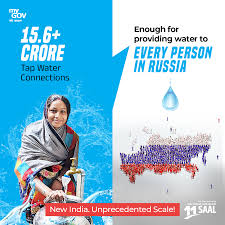Jal Jeevan Mission (JJM)

- 13 Aug 2025
In News:
The Jal Jeevan Mission (JJM), launched in August 2019, aims to provide Functional Household Tap Connections (FHTCs) to every rural household, ensuring safe, adequate, and regular potable water supply. At the time of its launch, only 17% of rural households (3.23 crore) had tap water access. As of 14 August 2025, this has increased to 81% coverage (15.68 crore households) out of a total 19.36 crore rural households, with over 12.45 crore additional connections provided.
Institutional Framework
- State Subject: Drinking water supply is primarily the responsibility of States/UTs, while the Centre provides technical and financial support.
- Funding: An initial outlay of ?2,08,652 crore was approved; the scheme has now been extended until 2028 with enhanced allocation for completing pending works and strengthening Operation & Maintenance (O&M).
- Citizen Participation: The 2025 Budget emphasized “Jan Bhagidari” for sustainable and community-centric water service delivery.
Quality Standards and Monitoring
- Benchmark: Water quality is mandated to comply with BIS:10500 standards, which specify acceptable and permissible limits for chemical, physical, and bacteriological parameters.
- Testing: In December 2024, the government released a Concise Handbook for States/UTs, recommending comprehensive testing at multiple points—source, treatment plant, storage, and distribution.
- Remedial Actions: Include regular cleaning of overhead tanks and corrective measures in case of contamination.
- Transparency Tools:
- JJM Dashboard “Citizen Corner” displays village-level water test results.
- Complaints can be filed via CPGRAMS (pgportal.gov.in) and the Department’s website (jalshakti-ddws.gov.in).
- Aadhaar-linked monitoring, geo-tagging, IoT sensors, and third-party inspections are employed for real-time tracking.
Significance
- Public Health: Ensures safe drinking water, reducing the burden of waterborne diseases.
- Gender Empowerment: Frees women and girls from time-consuming water collection, enabling better education and livelihoods.
- Rural Development: Improves quality of life, reduces drudgery, and enhances rural productivity.
- Sustainability: Integrates with groundwater management initiatives like the Atal Bhujal Yojana, promoting long-term water security.
Current Status (2025)
- Coverage: 81% rural households have tap water supply.
- Target: Universal coverage by 2028 with a focus on infrastructure quality, O&M, and sustainable, citizen-driven service delivery.
